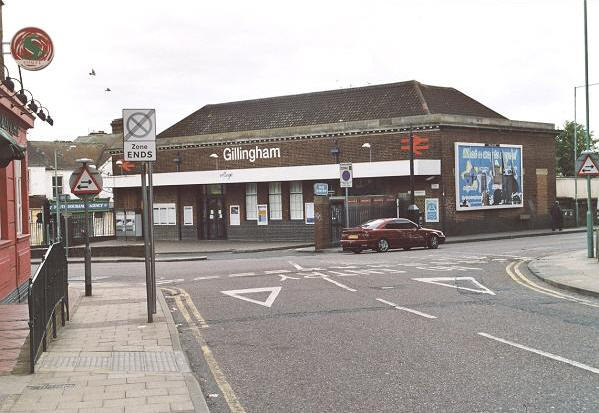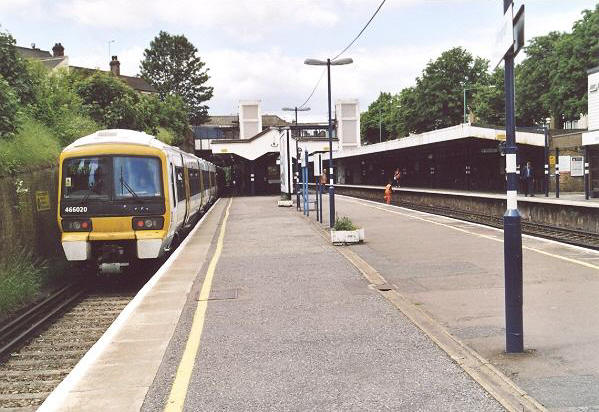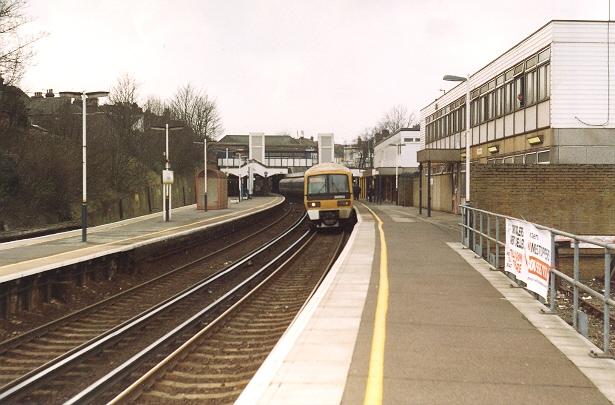
Gillingham
The station opened with the East Kent Railway's first stretch of operational railway between Faversham and Chatham on 25th January 1858 and was built to the architecture which became standard for this company's intermediate stations. From the outset, the name boards proclaimed ''New Brompton'', an area of Gillingham, and the layout employed here was what is now considered familiar on the ''Chatham'' main line: two platforms were situated either side of the double track, the main station building being located on the ''down'' side. The station building itself can readily be likened to a cross between the examples still in existence at Shepherds Well and Farningham Road - combine the layout of the former with the two-storeys of the latter and the general outline of Gillingham's bricks and mortar would be created. The ''up'' side was host to the typical secondary waiting facilities, these comprising of a single timber waiting shelter, and as per usual at such stations, no footbridge was provided from the outset, this coming circa 1894. Naturally, a single-track goods shed was in evidence at this site, located on the ''down'' side, to the east of the platforms.
The first signs of layout expansion occurred in 1877 with the commissioning of the single-track Chatham Dockyard branch. Opening on 16th February of that year, it trailed off the ''down'' line, to the east of the platforms, with a north westerly heading, thus could only be accessed by trains travelling in the ''up'' direction. With this quaint line also came a couple more sidings for freight stock storage, but even greater change was yet to come. In 1884 the LC&DR drew up plans for an engine shed at New Brompton, located on the ''up'' side, to the east of the platforms. Construction work started in that year, completion coming in 1885, which provided a three-road dead-end pitched roof building, just over 260 foot in length, to the east of the platforms. With this complex came four lengthy sidings and a 50 foot turntable - a coaling stage sat adjacent to the latter in SE&CR days. A year after the shed's opening, the station gained a suffix, becoming ''New Brompton (Gillingham)''. It would now be appropriate to mention the presence of three signal boxes on site: the first opened in 1877 with the dockyard branch, it being situated within the apex of the junction and exclusively controlling access to the single-track line. The remaining two signal cabins opened concurrent with each other at a later date, most likely with the aforementioned engine shed. Both situated on the ''up'' side, the Saxby & Farmer-designed structures were located: A) behind the platform, to the east of station structures and: B) at the eastern most extremity of the layout, immediately adjacent to the level crossing.
Now onto the SE&CR era. Three noticeable changes occurred during this company's reign and the most prominent of these for the general traveller was to the station name; it became just plain ''Gillingham''. The second modification was to the engine shed: this became a through affair on the extension of two out of the three lines through the rear of the building, these terminating at a coal stack. With the formation of the joint managing committee, locomotive affairs between the formerly separate SER and LC&DR also saw cooperation, which included the classification of both Strood and Gillingham sheds as essentially one depot. In reality, this meant that the two shared the same allocation of locomotives, thus the same shed code was used, but engine exchanges between these sheds and Faversham continued in frequency. Finally, this company also converted the ''up'' platform into an island arrangement, implementing the same canopy design as it had done at Rochester; therefore, this would put the modifications circa 1911. The greatest station upheaval undoubtedly came under Southern Railway ownership, when this company initiated a modernisation programme in 1932. This included the building of a new road bridge to the west of the platforms, which allowed for a new main station building to straddle the tracks. Evidently, the LC&DR practice of doing this was being followed here, Chatham having already seen its original platform-level station building superseded in 1886. It may initially seem unusual as to why the LC&DR did not undertake the same modification work concurrently at Gillingham, but no road bridge across the tracks was in evidence at the latter. The new road bridge and station building were located far enough west to allow retention of the original ''New Brompton'' structure - for now. A footbridge of steel construction replaced the lattice example, and this took an unusually circuitous route to the ''down'' platform, seemingly circumnavigating a proportion of the island. At the end of the decade, in 1939, the station also became the terminating point for the SR's ''Chatham'' line electrification. It had been included within the company's suburban third rail schemes, which resulted in the closure of Strood shed and the halving of Gillingham's locomotive allocation, scheduled electric services commencing on 2nd July. For this, a four-road EMU depot opened on the ''up'' side, to the east of the level crossing, complete with a carriage washing facility. Previously, in 1923, the station had acquired the county's suffix, thus was now ''Gillingham (Kent)''.
Under British Railways, the most prominent project to affect Gillingham was that of the Kent Coast Electrification Scheme. This saw the lengthening of platforms at their eastern ends with concrete and the installation of colour light signalling. The ''juice'' was live for the accelerated electric timetable to come into use on 15th June 1959, marking the end of regular steam on the ''Chatham'' main line. Steam locomotives were progressively transferred to those still active South Eastern Division sheds along the ex-SER main line, but that at Gillingham remained operational - at least on paper - until June 1960. The shed was subsequently demolished and the land sold for private commercial purposes, although part of the site today is once again used for railway purposes, now occupied by a state-of-the-art signalling centre, opened in 1994. As part of the 1959 works, the ornate valance of the island platform was replaced with a plain metal equivalent. Sadly, the original station building of 1858 was also to succumb; in 1970, it gave way to the dreaded ''CLASP'' structures associated with the era, these subsequently being used by staff. That was followed three years later by the closure of the Saxby & Farmer signal box behind the island platform and that which controlled the dockyard branch, their functions transferring to the remaining cabin adjacent to the level crossing.

The Southern Railway's modernisation of 1932 saw this high-level entrance come into use. Despite
this, the original LC&DR station building on the ''down'' platform remained in existence until the
1970s. The 1932 structure is seen on 31st May 2006. David Glasspool

A westward view on 31st May 2006 reveals the prominent SR architecture. The island platform
retained its stylish SE&CR canopy until 1959. However, this itself had been partially demolished
during the SR modernisation, as the next picture will show. The two towers in evidence, one on
each platform surface, are lifts. No. 466020 is on the left, forming the rear of a service to Charing
Cross via Dartford. David Glasspool

An earlier westward view from 11th March 2004 reveals Class 365 No. 365512 awaiting departure,
and the structures from 1970, which replaced the delightful LC&DR building of 1858. This was retained
after the 1932 modifications to provide accommodation for the Station Master. David Glasspool
Return to the Kent Rail Homepage or alternatively, check for Updates.
Website & Copyright information - Links - Contact the Webmaster
All content is copyright © David Glasspool